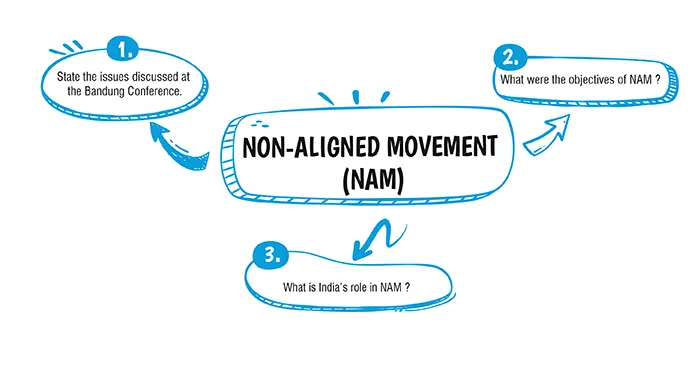Home / Board / ICSE / important Questions / Class 10 / History & Civics / Non-Aligned Movement (NAM)
Table of Contents

Ans.(c) Yugoslavia, Indonesia, Egypt,India
Explanation:
The founders of the Non-Aligned Movement (NAM) were Nasser of Egypt, Sukarno of Indonesia ,Tito of Yugoslavia,Jawaharlal Nehru of India and Kwame Nkrumah of Ghana.
Ans.(d) Cold War
Explanation:
Once allies during World War II, the United States and the Soviet Union became competitors on the world stage and engaged in the Cold War,
Explanation:
(i) The five principles of Panchsheel were given a practical shape at the Bandung Conference of 1955.
(ii) The delegates condemned colonialism.
(iii) The need for economic growth in third world countries was emphasised on.
Explanation:
Objectives of NAM were :
(i) To eliminate all those causes which would lead to war.
(ii) To protect the nascent freedom of the newly born independent countries of Asia and Africa from colonial domination.
(iii) To oppose colonialism, imperialism and racial discrimination.
(iv) To advocate sovereign equality of all states.
(v) To encourage friendly relations among countries.
(vii) To advocate peaceful settlement of international disputes.
(vii) To oppose the use of force and the use of nuclear weapons.
(viii) To strengthen the United Nations as an organ of world peace.
(ix) To protect human rights and to protect the environment.
(x) To build a new international economic order based on equity, equality and justice.
Explanation:
India’s role in NAM :
(i) Jawaharlal Nehru played a leading role in the evolution of NAM. It was Jawaharlal Nehru who elaborated, refined and popularised the concept of non-alignment. Nehru along with Nasser of Egypt and Marshal Tito of Yugoslavia played the leading role in the evolution, establishment and consolidation of Non-Aligned Movement.
(ii) Nehru, before independence convened the Asian Relations Conference in New Delhi in March 1947, which was instrumental in forging unity among Asian nations.
(iii) He enunciated the five principles of peaceful co-existence named Panchsheel. These principles are also the core principles of the NAM.
(iv) A policy of friendship, cooperation and world peace was pursued under him. He pleaded for disarmament as the only means of preserving peace in the world.
Download Mind Map of this chapter
Download NowWant to Practice Mock Tests of this chapter
Practice NowDownload Important Questions of this chapter
Download NowCBSE Important Questions Class 10
ICSE Important Questions Class 10
CBSE Important Questions Class 10
ICSE Important Questions Class 10